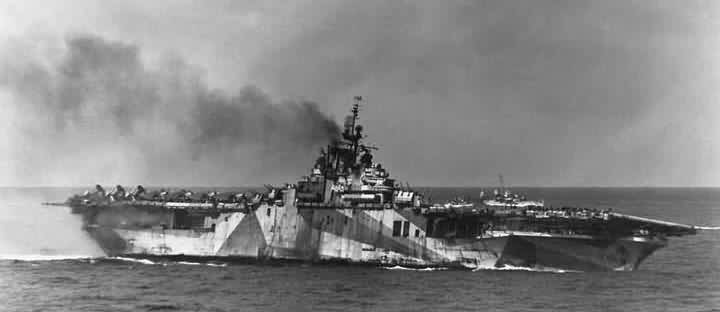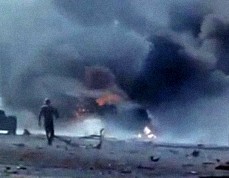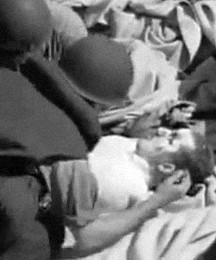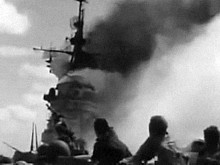| "Some things I think I remember are hazy at best; other memories are as plain as if the event was recent. -- Rex K. Pearson Lieutenant, VB-80
| While the crew were ordered into action to save the endangered carrier, Captain Kiefer conned his ship skilfully. First, he changed course to keep the wind from fanning the blaze. Then, he ordered magazines and other compartments flooded to prevent further explosions and to correct a 10° starboard list. Finally, he instructed the damage control party to continue flooding compartments on Ticonderoga's port side which induced a 10° port list which dumped the fire overboard. Firefighters and aircraft handlers completed the dangerous job of dousing the flames and jettisoning burning aircraft.
Years later many who survived that tragic day were asked to recall what they remembered. Though it is painful to recall for most, they did their best just as they did on that fateful day so long ago. Below are some of those memories recalled by crew members.
Rex K. Pearson Lieutenant, VB-80
The Japanese Kamikaze attack on the USS Ticonderoga on January 21, 1945, effectively ended my career as a pilot with the US Navy. The memory of that day and events immediately following come and go. Some things I think I remember are hazy at best; other memories are as plain as if the event was recent. This is what I remember of that day.
According to my flight log, my gunner, Bob Bennett, and I had returned with the VB 80 squadron from an air raid over Formosa. We had finished de-briefing when the first Kamikaze hit the deck. For some reason, I do not remember why, I had already left the ready room and was in my room when it hit. I opened the door, but the smoke was heavy and bulkheads were hot. It seemed safest to go get out some other way, so I chose the porthole. Being rather small at this point was an advantage, although I had to remove my helmet and leave it behind. I got out halfway, yelled for a rope and climbed to the deck hand-over-hand. Once there, I went to a gun implacement, thinking I could help as there were other Jap planes coming in for the kill. Then the second one struck about 50 feet from where I was standing. The gunners did a great job, their shots were accurate, bits and pieces of the plane were flying everywhere. The pilot was undoubtedly dead by then, but the plane stayed in the dive. Seconds before he hit, I grabbed a swabbie bucket, put it over my head and crouched as low to the deck as I could.
From here is where the picture gets hazy. I got up, started moving, blood pouring, smoke and fire everywhere, men shouting. I saw Lt. Everett Wehr and he called to me, "Rex, I'm dying, I'm dying." He had been hit mid-section, his body almost cut in half. I put my arm around his shoulders and patted him. It was all I could do. Somehow, I got to the flight deck. My roommate, Lt. George Walsh, apparently stayed with me and told me later they poured plasma into me, in and out of consciousness. Lt. Paul Dull later held me in the shower to help me clean up and wrote to my wife to explain, as best he could, what had happened.
I cannot remember how long it was before I went with the other wounded aboard a hospital ship, nor what happened subsequently. I do know that Lt. Forbes Perkins helped me out by persuading the doctors to send me, along with him to the hospital in San Diego where we stayed several weeks before going home on medical leave. Perkins had to talk for me, the head wound apparently knocked out my speech, and I had some difficulty with locomotion as I had lost all
feeling in my left side.
Irving L. Patterson Ensign VB-80
On January 21, 1945, I had just landed back on board the Ticonderoga from a bombing mision over Formosa. I was sitting in Ready Room 1 and had just lit up a pipe. I sat in the aisle seat instead of my usual seat next to the aft bulkhead, 5 rows back from the front of the ready room. Suddenly the first Kamikaze plane went through the flight deck across the passage from ready Room 1.
I became Airbourne when the bombs went off and came down in a jumbled mess of seats and debris. If I had been in my regular seat I would have been killed. Huge pieces of shrapnel went through the seat and through the flight deck bulkhead. I remember the Skipper yelled, "Stay put, I'll find a way out and come back and get you." He didn't come back and smoke filled the ready room. The only thing we could see was the red light on the squawk box. We called operations via the box and were told to go amidship and aft to get out. I was so glad to see daylight and smell fresh air.
We went to the port catwalk, then to the flight deck where we saw our Skipper, E.L. Anderson, in a stretcher. He was burned and yelling, Throw me overboard."
The second Kamikaze started to dive on the ship and Lt. Blatchford and I headed aft to the chain guard rail. We talked about jumping off the carrier but decided against it. The Kamiaze pilot took aim on the island as his target instead of the parked planes on the flight deck.
Blatchford and I watched the Jap hit the island. I guess we threw our arms over our heads as we had no other way to protect ourselves. A lot of officers and men spent the night on the fantail. V-B 80 pilots and crew transferred to the USS Hancock and finished out the tour.

USS Ticonderoga CV-14 listing after a second kamikaze hit
Andrew Sterling AMM2c
January 21, 1945, started out as every other day with much apprehension and wondering what this day held in store.
About noon I was assigned the job of repairing the radar equipment on the wing of an SB2C and, while working, looked over toward the other ships and saw two Japanese planes coming in. One took a course toward the other carriers in the fleet, the other one came in on the aft end of the carrier at low altitude, just clearing the folded wings of planes already loaded and fueled for another mission.
As the planes flew over I was able to see the pilot and I could have thrown a wrench and hit the plane if I chose to do so. It appeared his destination was the area of the forward elevator. then, all hell broke loose.
After gathering our wits we assessed the damage and tried to look after the injured and dead. In the meantime, I don't recall the time element between the first and second impact, another plane came in at a level of the top part of the island and as he hit, some of the gunners stayed at their posts and fired continuously until the plane hit the gun mount and the island. Some of the gunners jumped overboard after being hit and others didn't survive. At the time of the impact I was directly across
on the flight deck where I was able to view the whole sequence of events.
Later, we made every effort to save the ship and assist the injured and remove the dead. As I reflect on all that happened that day, I can't help but marvel the fact these men were able to muster the strength and courage to pick up 250 lb. bombs and throw them overboard, or the many other acts of bravery displayed. I served aboard the USS Ticonderoga with a great group of men.
Vincent P. Struck MM1c
I was standing in the chow line as I was scheduled to go on watch, but before we could eat they sounded General Quarters. I went to my station which was the after engine room. Just s I got there I felt the ship kind of jump. I told the fellows we had been hit and shortly thereafter smoke started coming out the ventilators so we had to shut them down.
After the attack I went up on the hangar deck to do what I could to help. One man asked for a corpsman. He was bandaged and said his eyes hurt but the corpsman told me he didn't have any eyes. I helped carry people to Sick Bay and I was amazed when the injured would say, take him - he's worse than I am. I'm proud to have been part of the Ticonderoga along with all my great shipmates. It makes me sick to see the world in this condition with all the fighting.
Repair and Relaunch
The stricken carrier arrived at Ulithi on 24 January but remained there only long enough to move her wounded to hospital ship Samaritan, to transfer her air group to Hancock, and to embark passengers bound for home. Ticonderoga cleared the lagoon on 28 January and headed for the U.S. The warship stopped briefly at Pearl Harbor en route to the Puget Sound Navy Yard where she arrived on 15 February. Captain William Sinton assumed command in February 1945.
Her repairs were completed on 20 April, and she cleared Puget Sound the following day for the Alameda Naval Air Station, Alameda, California. After embarking passengers and aircraft bound for Hawaii, the carrier headed for Pearl Harbor where she arrived on 1 May. The next day, Air Group 87 came on board and, for the next week, trained in preparation for the carrier's return to combat. Ticonderoga stood out of Pearl Harbor and shaped a course for the western Pacific. En route to Ulithi, she launched her aircraft for what amounted to training strikes on Japanese-held Taroa in the Marshalls. On 22 May, the warship arrived in Ulithi and rejoined the Fast Carrier Task Force as an element of Rear Admiral Radford's TG 58.4
^ back to top ^ ^ Page 1 ^ ^ Page 2 ^ ^ Page 1 ^ ^ Page 2 ^
Home Contact Me
 Some graphics may link to items for purchase from our partners and help support this site. It's a win win!
Some graphics may link to items for purchase from our partners and help support this site. It's a win win!
copyright cv14 - © 2020 cv14 - All rights reserved.
|


